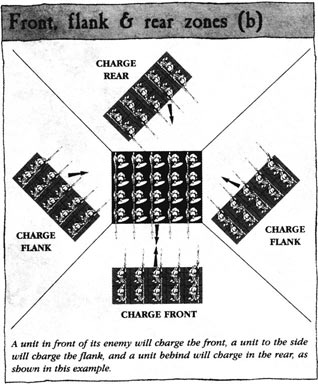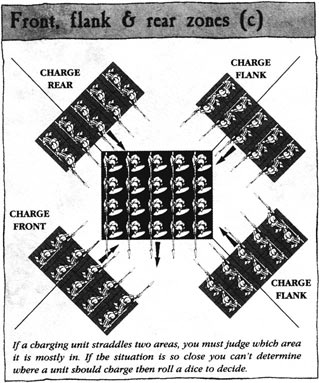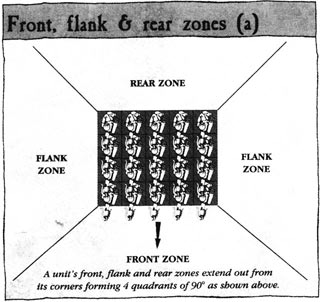Individual models can turn to face the chargers and avoid this test and any other penalties, unless they are already engaged in close combat. Troops who are charged in the flank or rear whilst they are already fighting other enemy who engaged them on the previous turn(s) must take a Panic test to see whether their nerve holds, as described later. This test is taken as soon as it is established that chargers are within range, but before moving any troops. The rules for Panic tests and other psychological tests are explained in full in the section on Psychology. If a unit is charged in the flank or rear by a unit with a unit strength of five or more then it loses any rank bonuses that it would otherwise have in close combat. Units that are ranked up in depth normally fight better because the troops in the rear ranks are able to physically support those in the front, lending their weight to the formation, but a unit which is charged in the flank or rear will lose this advantage. See the Close Combat section for details of combat results and how rank bonuses work. If a unit is attacking an enemy in the flank or rear, it gains the advantage of fighting a formation unprepared to fight in that direction. Consequently, the attackers receive extra combat bonuses, as described in the Close Combat section. Marching at the double allows troops that are away from the main fighting zones to move more rapidly. This represents the swift movement of reserves to a critical area by means of a rapid march and helps to ensure that units do not get stranded away from the fighting. 
Marching troops move at twice their normal Movement rate with weapons sheathed or shouldered. They are literally 'going at the double'. A unit that is on the march is not prepared for combat so marching is not suitable for a unit that is close to the enemy. In reality, no troops would approach the enemy with their weapons unready to defend or attack with. Troops can march if there are no enemy models within 8" of them at the start of the turn. If there are enemy models (fleeing enemies do not count) anywhere within 8" at the start of the turn, the unit is too busy preparing to fight and so cannot march. Note that the marching unit can move closer than 8" to an enemy as it moves. A unit on the march cannot change formation or turn as this would disrupt its movement. It can wheel as normal, as you might imagine a column of troops would in order to follow a route or path, for example. A marching unit cannot move through difficult or other obstructive terrain or cross obstacles. It must stop if it comes to these features. A unit that is on the march cannot shoot missile weapons during the Shooting phase. It is unprepared for combat and any weapons it carries are not ready to be used. Any Wizards with the unit can still cast spells. Units which consist of models that move individually, such as Giants or large monsters with or without riders, can march move in the same way as units of troops. In the case of individual models their speed bonus is not due to them 'marching' in formation but takes account of their freedom to move, breaking into a run, and so forth. 
A unit deployed in a column with models lined up one behind the other can move very easily. The lead model is not restricted by troops either side and so can choose a snaking path which twists about. This is called snaking. Trailing models are placed so that they follow the path of the lead model. This a special type of movement unique to long lines of troops. It isn't a very practical formation for fighting, but it is very handy for threading your way through buildings and between obstacles. Players will sometimes find that the movement of troops results in the tabletop becoming quite crowded, especially when several different units are engaged in close combat fighting. It is obviously important to establish what units are actually fighting and which are close by but not engaged, eg, perhaps merely passing by. For this reason, opposing troops are kept at least 1" apart when they are not fighting. Models which would otherwise approach to within 1" of an enemy without engaging them are simply halted 1" away. Remember that units may only engage in close combat by means of a charge, except in exceptional circumstances. These are clearly indicated in the rules. This rule is ignored during charge moves - a charging unit may approach within 1" of any enemy. This is done for the purposes of game mechanics. After movement is resolved, it is time for the Magic phase. If you are new to the Warhammer game we recommend that you ignore magic for now and familiarise yourself with the rules for shooting and close combat. If you wish to learn how magic works, turn to p.134. |
 Being
charged from a direction you cannot see and thought was safe is a frightening
thing for even the bravest of troops. With his held of vision narrowed
by his position in the ranks, the average soldier has only a limited
knowledge of what is happening on the battlefield. If the enemy has
somehow got round behind him he might reasonably assume that the battle
is lost. Doubt will be sown in his mind and he may become disoriented
and confused. His fighting efficiency may even become impaired. If he
is fighting in close combat, he might panic and flee, thinking that
the enemy is upon his unguarded back.
Being
charged from a direction you cannot see and thought was safe is a frightening
thing for even the bravest of troops. With his held of vision narrowed
by his position in the ranks, the average soldier has only a limited
knowledge of what is happening on the battlefield. If the enemy has
somehow got round behind him he might reasonably assume that the battle
is lost. Doubt will be sown in his mind and he may become disoriented
and confused. His fighting efficiency may even become impaired. If he
is fighting in close combat, he might panic and flee, thinking that
the enemy is upon his unguarded back.